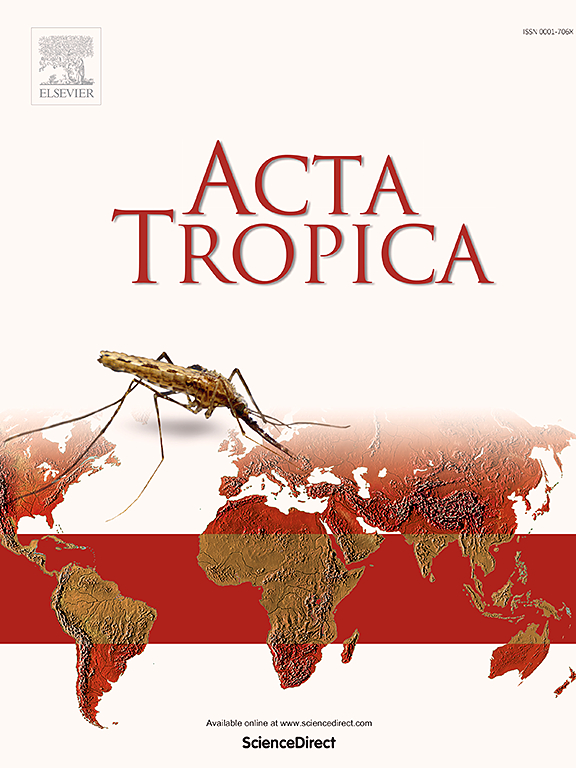引起不同类型蝇蛆病的三种蝇科(双翅目)种消化系统的比较幼虫解剖
IF 2.1
3区 医学
Q2 PARASITOLOGY
引用次数: 0
摘要
蝇科是主要的双翅目昆虫之一,包括被称为蝇蛆病的寄生虫病的媒介。寄生性似乎在栉蜂科中独立进化了多次;因此,这个科包括多种引起蝇蛆的物种,它们的专性或兼性习性以及它们在宿主中的特定位置各不相同。幼虫形态研究可以为这些物种的生物学以及蝇蛆病的发病机制和进化提供新的和相关的见解;然而,内部器官和结构的解剖-特别是消化系统内的解剖-通常被忽视,尽管可能反映寄生适应。本文采用无创x射线显微计算机断层扫描技术研究了三种calliphidae物种三龄幼虫的消化系统解剖结构:Protocalliphora azurea(雀形目鸟类雏鸟嗜血蝇病的专性剂);哺乳动物皮下蝇蛆病的专性病原体——嗜人虫草菌;丝光Lucilia sericata是哺乳动物创伤性蝇蛆病的兼性病原体。这三个物种在消化器官的内部解剖结构上相对一致,尽管它们在唾液腺的形状和大小上有所不同——唾液腺是幼虫抗原的主要来源——在azurea中要小得多。此外,这三种幼虫在胃盲肠和作物存在的情况下,不同于雌蛾科的幼虫,雌蛾科是一个密切的科,只包括专性引起蝇蛆病的物种,这表明在丝光l.s icata中具有显着的储存能力。观察到的差异从功能的角度进行了讨论,并与引起蝇蛆病的类型有关。本文章由计算机程序翻译,如有差异,请以英文原文为准。

Comparative larval anatomy of the digestive system of three Calliphoridae (Diptera) species that cause different types of myiasis
The Calliphoridae are one of the main Diptera families that include agents of the parasitic disease condition known as myiasis. Parasitism seems to have evolved multiple independent times within the Calliphoridae; consequently, this family includes a diversity of myiasis-causing species, varying in their obligate or facultative habits and in their specific location in the host. Larval morphological studies can provide novel and relevant insights into the biology of those species, as well as on the pathogenesis and evolution of myiasis; however, the anatomy of internal organs and structures —particularly those within the digestive system— has generally been overlooked, despite potentially reflecting parasitic adaptations. We use here non-invasive X-ray micro-computed tomographic techniques to study the anatomy of the digestive system of the third instar larvae of three Calliphoridae species: Protocalliphora azurea, an obligate agent of sanguinivorous myiasis in passerine bird nestlings; Cordylobia anthropophaga, an obligate agent of subcutaneous myiasis in mammals; and Lucilia sericata, a facultative agent of traumatic myiasis in mammals. The three species are relatively uniform in the internal anatomy of their digestive organs, although they differ in the shape and size of the salivary glands —a main source of larval antigens—, which are considerably smaller in P. azurea. Moreover, the three species differ from the larvae of Oestridae, a close family that exclusively includes obligate myiasis-causing species, in the presence of gastric caeca and a crop, which shows a remarkable storage capacity in L. sericata. The observed differences are discussed from a functional perspective and in relation to the type of myiasis caused.
求助全文
通过发布文献求助,成功后即可免费获取论文全文。
去求助
来源期刊

Acta tropica
医学-寄生虫学
CiteScore
5.40
自引率
11.10%
发文量
383
审稿时长
37 days
期刊介绍:
Acta Tropica, is an international journal on infectious diseases that covers public health sciences and biomedical research with particular emphasis on topics relevant to human and animal health in the tropics and the subtropics.
 求助内容:
求助内容: 应助结果提醒方式:
应助结果提醒方式:


